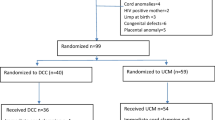Abstract
Objective: To study the maternal risk factors and clinico-bacteriological profile of early onset sepsis (EOS), in a tertiary care neonatal unit.Methods: Relevant data of neonates born during the study period were obtained from their case records. A diagnosis of early onset sepsis was made if either clinical sepsis developed within 72 hours of life or if positive blood/CSF cultures were obtained in those with potential maternal risk factors. Statistical analysis was done using Odds Ratio or Chisquare and Fisher’s exact t-test as applicable.Results: Among 1743 live births, a total of 69 episodes of sepsis occurred in 65 neonates (43% culture proven) with an incidence of 37.2 per 1000 live births. The incidence of EOS was 20.7 per 1000 live births and it constituted 55.4% of overall sepsis. Among the perinatal risk factors assessed, a significant association of EOS with prolonged rupture of membranes, foul smelling liquor, dai (midwife) handling and maternal urinary tract infection was observed (p<0.05). Among infants at risk of EOS, 20.6% developed sepsis compared to only 0.5% of those without these risk factors (p 0.001). Even among those at high risk such as low birth weight, preterm, and asphyxiated neonates, incidence of EOS was negligible in the absence of a maternal risk factor. Pneumonia (66.7%), shock (27.7%), metabolic acidosis (19.4%) and meningitis (8.3%) were the comorbidities seen among the cases. Culture proven EOS occurred in 41.6%,Pseudomonas being the commonest (60%) isolate. The case fatality rate was 19.4%.Conclusion: Screening for sepsis in an asymptomatic neonate is warranted only in the presence of a maternal risk factor even if the neonate is at high risk of developing sepsis due to associated problems of prematurity, low birth weight or asphyxia. Knowledge of likely causative organisms of EOS can aid in instituting prompt and appropriate therapy, in order to minimise morbidity and mortality.
Similar content being viewed by others
References
Baley JE, Goldfark J. Neonatal infections. In Klaus MH, Fanaroff AA eds.Care of the High-risk Neonate. 5th ed. Philadelphia. NB Saunders Co. 2001; 363–392.
Singh M. Perinatal Infections. In Singh M, ed.Care of the Newborn. 5th Ed. New Delhi: Interprint; 1999; 198–221.
Tallur SS, Kasturi AV, Nadgir SD, Krishna BVS. Clinico-Bacteriological study of Neonatal Septicaemia in Hubli.Indian J Pediatr 2000; 67: 169–174.
Kuruvilla KA, Pillai S, Jesudasan M, Jana AK. Bacterial profile of sepsis in a Neonatal Unit in South India.Indian Pediatr 1998; 35: 851–858.
Schuchat A, Zywicki SS, Dinsmoor MJ, Mercer B, Romaguera J, O’Sullivan MJet al. Risk factors and opportunities for prevention of early-onset neonatal sepsis: a multicenter case-control study.Pediatrics 2000; 105: 21–26.
Clemente Yago F, Tapio Collados C, Escriva Tomas P, Rubio Coriano A, Garcia Martinez R, Jimenez Cobo B. Neonatal septicemia: Incidence and risk factors.An Esp Pediatr 1992; 37: 481–483.
Schuchat A, Oxtoby M, Cochi Set al. Population based risk factors for neonatal group B streptococcal disease: Results of a cohort study in metropolitan Atlanta.J Infect Dis 1990; 162: 672–677.
Soman M, Green B, Daling J. Risk factors for early neonatal sepsis.Am J Epidemiol 1985; 121: 712–719.
Stoll BJ, Gordon T, Korones SB et al. Early onset sepsis in very low birth weight neonates: A report from the National Institute of Child Health and Human Development Neonatal Research Network.J Pediatr 1996; 129: 72–80.
Oddie S, Embleton ND. Risk Factors for Early onset Neonatal Group B Streptococcal Sepsis: Case control study.BMJ 2002; 325: 308.
Bhutta ZA, Yusuf K. Early-onset neonatal sepsis in Pakistan: A Case Control study of risk factors in a birth cohort.Am J Perinatol 1997; 14: 577–581.
Pass M, Khare S, Dillon HC Jr: Twin pregnancies: Incidence of group B streptococcal colonization and disease.J Pediatr 1980; 97: 635–637.
Report of the National Neonatal Perinatal Database (National Neonatology Forum) 2000.
Vargas PE. Bacteremia and Neonatal sepsis.Rev Med Panama 1990; 15: 127–137.
Anwar SK, Mustafa S, Pariyani S, Ashraf S, Taufiq KM. Neonatal sepsis: an etiological study.J Pak Med Assoc 2000; 50: 91–94.
Leibovitz E, Flidel-Rimono O, Juster-Reicher A, Amitay M, Miskin A, Barak Yet al. Sepsis at a Neonatal Intensive Unit.Isr J Med Sci 1997; 33: 734–738.
Author information
Authors and Affiliations
Corresponding author
Rights and permissions
About this article
Cite this article
Chacko, B., Sohi, I. Early onset neonatal sepsis. Indian J Pediatr 72, 23–26 (2005). https://doi.org/10.1007/BF02760574
Published:
Issue Date:
DOI: https://doi.org/10.1007/BF02760574




